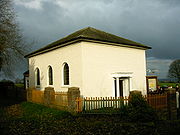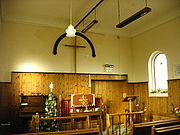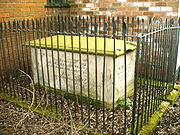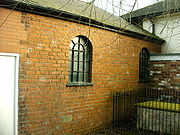
Plealey
Encyclopedia
Plealey is a small village in Shropshire
, England
. It is located between Pontesford
and Longden
.
The village lies in the parish
of Pontesbury
and has a population of 122 (2001 Census).
There is a post box and a Methodist Chapel. On the last Saturday of August a street market
is held, an usual event for such a small village.




Chapel at Plealey is interesting in that it was built by Richard France, a resident of the village. Richard France, in 1825, and Edward Owen, in 1826, had licensed their houses as "dissenting meeting houses". By 1828, Richard France decided to build a chapel, and bought a piece of land opposite his house. He bought for five shillings, "the parcel of land known as Corfield's Yard" for the purpose of erecting a chapel "for the use of Preachers of the Methodist Conference as established by the late John Wesley
". It was, however, originally licensed as a Congregational Chapel.
The practice of an individual building a chapel is not unique. For example, in 1801, John Lomas of Hollinsclough
built a Methodist chapel in his garden. This chapel is still in use and a key part of village life.
In the 1830s, Richard France (who still owned the chapel) had arranged for the chapel to be used by the Baptists. It was finally handed over to the Wesleyan Methodists in 1851. The 1851 Census records that 50 people attended services there.
In later years, some additions were made to the structure, to provide for toilets and a kitchen. The different brickwork on the photo of the rear of the building shows this. The outside of the main chapel is now painted white, and is of the same brick as the "Sunday School" at the rear. Modern brick gives away the later extensions. The porch also appears to be a later addition, not matching the simplicity of the original architecture, and having two layers of flashing over the join to the building.
Shropshire
Shropshire is a county in the West Midlands region of England. For Eurostat purposes, the county is a NUTS 3 region and is one of four counties or unitary districts that comprise the "Shropshire and Staffordshire" NUTS 2 region. It borders Wales to the west...
, England
England
England is a country that is part of the United Kingdom. It shares land borders with Scotland to the north and Wales to the west; the Irish Sea is to the north west, the Celtic Sea to the south west, with the North Sea to the east and the English Channel to the south separating it from continental...
. It is located between Pontesford
Pontesford
Pontesford is a small village in Shropshire, England.It is located on the A488 outside the large village of Pontesbury.It approximates to the northern extremity of the Pontesford-Linley geological fault, which trends approximately 11 miles to Linley near Bishops Castle...
and Longden
Longden
Longden is a village and civil parish in Shropshire, England. It is located southwest of Shrewsbury. There is a public house and a post office/shop, along with a church, and a primary school. It also has a village hall with a recreational field, childrens play park and a private tennis club...
.
The village lies in the parish
Civil parish
In England, a civil parish is a territorial designation and, where they are found, the lowest tier of local government below districts and counties...
of Pontesbury
Pontesbury
Pontesbury is a large village and civil parish in Shropshire and is approximately eight miles southwest of the county town of Shrewsbury. The village of Minsterley is just over a mile further southwest. The A488 road runs through the village, on its way from Shrewsbury to Bishop's Castle...
and has a population of 122 (2001 Census).
There is a post box and a Methodist Chapel. On the last Saturday of August a street market
Market
A market is one of many varieties of systems, institutions, procedures, social relations and infrastructures whereby parties engage in exchange. While parties may exchange goods and services by barter, most markets rely on sellers offering their goods or services in exchange for money from buyers...
is held, an usual event for such a small village.
Plealey Methodist Chapel




History
The MethodistMethodism
Methodism is a movement of Protestant Christianity represented by a number of denominations and organizations, claiming a total of approximately seventy million adherents worldwide. The movement traces its roots to John Wesley's evangelistic revival movement within Anglicanism. His younger brother...
Chapel at Plealey is interesting in that it was built by Richard France, a resident of the village. Richard France, in 1825, and Edward Owen, in 1826, had licensed their houses as "dissenting meeting houses". By 1828, Richard France decided to build a chapel, and bought a piece of land opposite his house. He bought for five shillings, "the parcel of land known as Corfield's Yard" for the purpose of erecting a chapel "for the use of Preachers of the Methodist Conference as established by the late John Wesley
John Wesley
John Wesley was a Church of England cleric and Christian theologian. Wesley is largely credited, along with his brother Charles Wesley, as founding the Methodist movement which began when he took to open-air preaching in a similar manner to George Whitefield...
". It was, however, originally licensed as a Congregational Chapel.
The practice of an individual building a chapel is not unique. For example, in 1801, John Lomas of Hollinsclough
Hollinsclough
Hollinsclough is a small rural Staffordshire village that lies by the River Dove in the English Midlands. It is within the Peak District National Park.-Location and geography:...
built a Methodist chapel in his garden. This chapel is still in use and a key part of village life.
In the 1830s, Richard France (who still owned the chapel) had arranged for the chapel to be used by the Baptists. It was finally handed over to the Wesleyan Methodists in 1851. The 1851 Census records that 50 people attended services there.
In later years, some additions were made to the structure, to provide for toilets and a kitchen. The different brickwork on the photo of the rear of the building shows this. The outside of the main chapel is now painted white, and is of the same brick as the "Sunday School" at the rear. Modern brick gives away the later extensions. The porch also appears to be a later addition, not matching the simplicity of the original architecture, and having two layers of flashing over the join to the building.
Architectural Riddle
This history answers the architectural riddle of a 19th century Methodist chapel with no inscription, unless one is hidden by the porch. The style is more typical of Primitive Methodists, but the building was assigned to the Wesleyans. When the chapel was built, it was normal Methodist practice to display both the date and the branch of Methodism. The plain style, almost square plan, with no inscription, is explained if Richard France built it as a Congregational chapel. However, this description would have allowed France the freedom to invite those preachers of whom he approved, Methodist, Baptist or Independent. There is no doubt as to his non-conformist Christian conviction. The attendance in 1951 shows that a substantial number in the village were non-conformists. It is possible that a factor in his decision was the greater respectability of the Wesleyans coupled with their being the most capable to maintain the building as a place of worship.Present day
The chapel is still in use, including by other denominations. For example, Shrewsbury Evangelical Church generally hold their Christmas morning services there.External links
- Gallery of Plealey Pictures (including Chapel)

